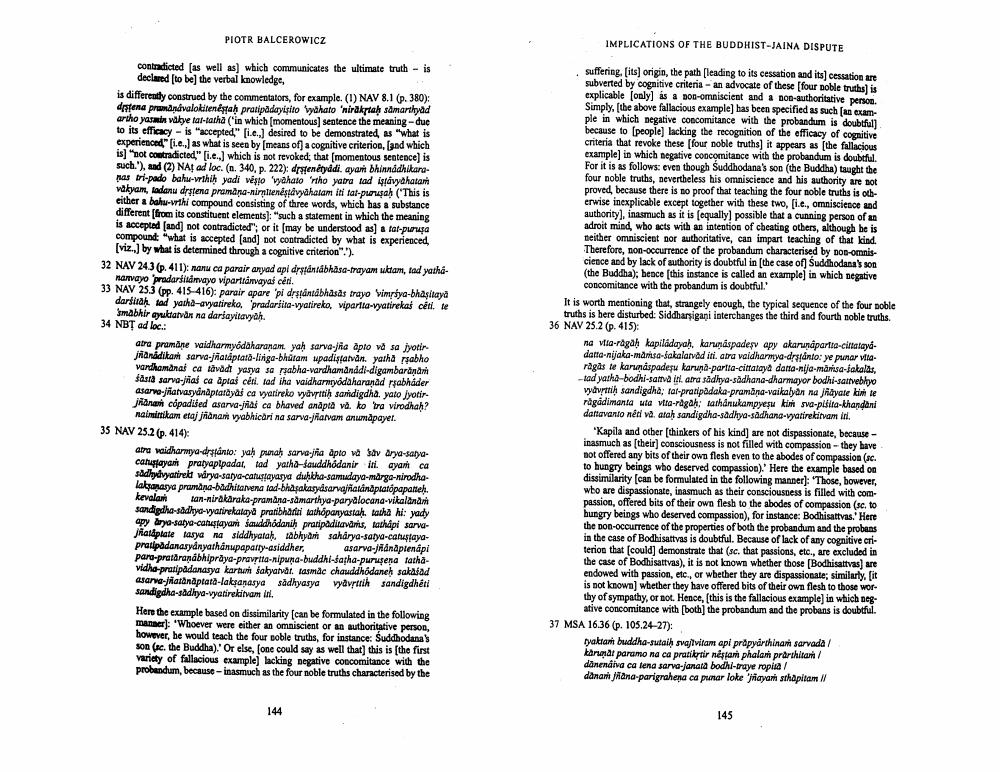________________
PIOTR BALCEROWICZ
IMPLICATIONS OF THE BUDDHIST-JAINA DISPUTE
is
our poble truth
ob omniscient and
Sumply (the above alle
ow: even thoughcomitance with the pears as the finitive
Dyl possible dating out of that kind ets with whitative, con un caracterised by the dans son
contradicted (as well as) which communicates the ultimate truth is
declared to be the verbal knowledge, is differently construed by the commentators, for example. (1) NAV 8.1 (p.380): dritena pruandvalokitenestah pratipõdayisito vyahato 'niräktah samarthyad artho yasmin wakyetar-tarha (in which (momentous sentence the meaning - due to its efficacy is accepted" fi.c.,) desired to be demonstrated, as "what is experienced" (i.c.,) as what is seen by means of a cognitive criterion, (and which is not contradicted" [ie..) which is not revoked that momentous sentence] is such."), and (2) NA ad loc. (n. 340, p. 222): drstenéryddi. ayant bhinnddhikaranas tri-pado bahu vrtih yadi visto 'wahatotho yata ad avahatam vakyam, tadanu drstena pramana nimitenestávydhatam in tal-purah ("This is either a bahw-vrti compound consisting of three words, which has a substance different from its constituent elements) "such a statement in which the meaning is accepted and not contradicted", or it may be understood as] a tal-pura compount "what is accepted (and) not contradicted by what is experienced
(viz..) by what is determined through a cognitive criterion".") 32 NAV 243(p. 411): nanu ca parairanyad epi drsansabhasa-trayamuktam, tad yasha
nav pradaridayo vipartamvayas cēt. 33 NAV 253 (pp. 415 416): parair apare 'pi drstand bhasas trayo Vimya-bhasilayd
darth ind yasha-ayatieka, pradariita-watirko, vipartio-vatiekal calle
Imabhir guttavan na darsayilavah. 34 NBT ad loc.:
atra pramane waidharmyódaharanam. yah sarvaja apto vd sa jyotir janadikan sarva-jataptata-linga-bhutami wpadişavdayatha rabho vandhamanat ca avadhi yasya sa sabha vardhamanddi-digambaran dard sarvajal ca aptas cēti, tad iha vaidharnryódaharanad rabhader asarwolatvasydnaplatayas ca varireko vydvitih sandigdha, yalo jyotir. janan copaduted asarva-jrias ca bhaved anapta va ko tra virodhah?
nalitikametajana vyabhicari na sarvajavam arumapayer. 35 NAV 25.2 (p. 414):
atra waidharma-dranto: yah punah sarva-fia Aplo va sav Arya saya cauayan pratyaptpadar, tad yatha-sauddhádanir ini. ayant ca sadhylvantrekt dryo-salya-cahustayarya dukkha-samudaya-mdryo-nirodho laborary promo-badhiavena tad-Shasakarydsorganapapapatah. kavalat tan-nirakaraka-pramina-samarthya paryolocand-vikaland sondigdhe-sadhya-varietala pratibhari dahópanyastahtasha Wiyalty py Bryo-satya-cahay saddhodnih pratadiuvams, tadpisarvo adplate laye N siddhyarah, sabhyat saharya-saya-cahayapratipadanasydnyathanupapatty-asiddher, asarva-Jidnaplenápi paro-protranábhipraya-pravatta-nipuna-buddhasha.purusena fatha vidho pratipadanarya kartant sakyahat. tasmde chauddhodaneh sakajad asarva-Jatnaplata-laksanasya sadhyasya vyavstrih sandigdheti sandigdha-sadhya-vyatirekitamin. Hero the example based on dissimilarity (can be formulated in the following manner): "Whoever were either an omniscient or an authoritative person, however, he would teach the four boble truths, for instance: Suddhodanas son (sc. the Buddha).'Or else, one could say as well that this is (the first variety of fallacious example) lacking negative concomitance with the probandum, becauseinasmuch as the four noble truths characterised by the
suffering its origin, the path [leading to its cessation and its cessation are subverted by cognitive criteria - an advocate of these [four noble truths) is explicable (only) is a non-omniscient and a non-authoritative person. Simply, (the above fallacious example) has been specified as such (an exam ple in which negative concomitance with the probandum is doubtful] because to people) lacking the recognition of the efficacy of cognitive criteria that revoke these [four noble truths) it appears as the fallacious example) in which negative concomitance with the probandum is doubtful For it is as follows: even though Suddhodana's son (the Buddha) taught the four noble truths, nevertheless his omniscience and his authority are not proved, because there is no proof that teaching the four noble truths is otherwise inexplicable except together with these two, [i.c., omniscience and authority). inasmuch as it is (equallyl possible that a cunning person of an adroit mind, who acts with an intention of cheating others, although he is neither omniscient sor authoritative, can impart teaching of that kind. Therefore, non-occurrence of the probandum characterised by non-omniscience and by lack of authority is doubtful in the case of Suddhodana's son (the Buddha); bence this instance is called an example) in which segative
concomitance with the probandum is doubtful It is worth mentioning that, strangely enough, the typical sequence of the four noble
truths is bere disturbed: Siddharsigani interchanges the third and fourth noble truths. 36 NAV 25.2 (p. 415)
na vila-ragah kapilddayah, kannaspadeşv apy akarundpartta-citatayddattanijaka-masa-Sakalatvaditi.atra vaidharmyadranto: se punar vita ragas te karundspadesu karuna-parita-citataya datanja-masa-jakalas, -Iad yatha-bodhi-sativa i atrasadhya-sädhana-dharmayor bodhisattveblo Waytti sandigdha, tal-pratpadaka-pramana-vaikalyan na Mayate kim te rågadimanta wta vita-rågah: tathånukampyesu kisa-pidita-khandani dattavanto ned vå, atah sandigdha-sadhya-sadhana varirekitvami.
"Kapila and other (thinkers of his kind) are not dispassionate, because inasmuch as their consciousness is not filled with compassion - they have not offered any bits of their own flesh even to the abodes of compassion (s. to hungry beings who deserved compassion). Here the example based on dissimilarity can be formulated in the following manner): "Those, bowever, who are dispassionate, inasmuch as their conscioustess is filled with com passion, offered bits of their own flesh to the abodes of compassion (sc. to hungry beings who deserved compassion), for instance: Bodhisattvas.' Here the non-occurrence of the properties of both the probandum and the probens in the case of Bodhisattvas is doubtful. Because of lack of any cognitive criterion that could demonstrate that (sc. that passions, etc., are excluded in the case of Bodhisattvas), it is not known whether those [Bodhisattvas) are endowed with passion, etc., or whether they are dispassionate; similarly, it is not known) whether they have offered bits of their own flesh to those wor thy of sympathy, or not. Hence, (this is the fallacious example) in which nego
ative concomitance with [both the probandum and the probans is doubtful. 37 MSA 16.36 (p. 105.24-27):
yakran buddha-sutih svaj#vitam api prapyarthinam sarvada / karunāt paramo na ca pratitir nestami phalani prarthitam danendiva catena sarva-janata bodhi-traye ropita / danam ana.parigrahena ca punar loke "rayam sthapitam //
body
propertieste)
na ca prazikri bodhi-raytropil shapitam
144
145




